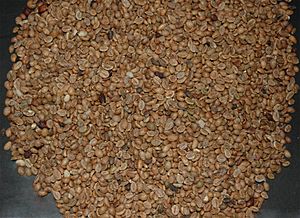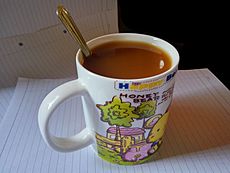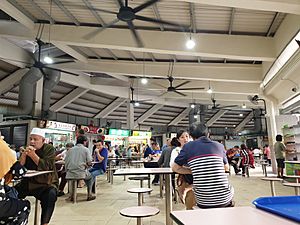Kopi (drink) facts for kids
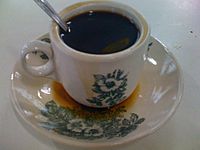
A cup of Kopi O
|
|
| Type | Served hot or cold |
|---|---|
| Region of origin | British Malaya |
| Color | Black or brown |
Kopi, also known as Nanyang coffee, is a traditional coffee drink found in several countries in Maritime Southeast Asia. It's usually made very strong and often served with sugar or milk. This drink started during the time of British Malaya, with roots in Hainanese culture.
The name Kopi comes from the Malay word for coffee. The term Nanyang means "South Sea" in Mandarin, referring to Maritime Southeast Asia. Many of the words used for Kopi come from the Hokkien dialect. This is because many people from the Minnan region in Fujian Province in China moved to Southeast Asia a long time ago. You can usually find Kopi in coffee shops, Hawker centres, and kopitiams across the region.
In Singapore, Kopi is a very important part of the culture and daily life for many Singaporeans. People of all ages and backgrounds often order their Kopi using Hokkien words. Singaporean Kopi is special because of how it's roasted and prepared, using a method similar to Torrefacto. Because of health concerns about diabetes, Singapore has campaigns to reduce sugar intake, especially in sweet drinks like Kopi O. This might change how much Kopi O people drink. You can learn more about Kopi's importance in Singapore's only Kopi museum.
Kopi is also a popular drink in Brunei, Malaysia, and Southern Thailand. Tenom in the East Malaysian state of Sabah is a big producer of coffee beans used to make Kopi.
Contents
How Kopi Got Its Name
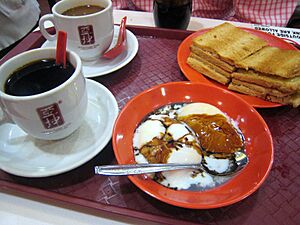
The use of the Hokkien dialect in Kopi culture is linked to the many Hokkien immigrants who came to Malaya and Colonial Singapore. In the 19th century, many people left China because of natural disasters and political problems.
By 1900, about 200,000 Chinese people had arrived in Singapore. The Hokkiens were the largest group among these Chinese immigrants. They also became very important in banking, manufacturing, and trade. This is why many of the words used to order Kopi come from the Hokkien dialect.
Different Kopi Drinks
Traditional Kopi comes in many styles. These styles depend on how strong it is, how much sugar it has, and if evaporated milk, condensed milk, or ice is added. Special Kopi words are used in Malaysia and Singapore to order your favorite style.
Here are some common ways to order Kopi in Singapore:
- Kopi: Coffee with sugar and condensed milk.
- Kopi-O: Coffee with sugar, but no milk.
- Kopi-O-Kosong: Coffee with no sugar and no milk.
- Kopi-C: Coffee with sugar and evaporated milk.
- Kopi-Peng: Iced coffee with sugar and condensed milk.
- Kopi-Siew-Dai: Coffee with less sugar and condensed milk.
- Kopi-Siew-Siew-Dai: Coffee with very little sugar and condensed milk.
- Kopi-Ga-Dai: Coffee with extra sugar and condensed milk.
- Kopi-Gao: Coffee with sugar, condensed milk, and extra thick, strong coffee.
- Kopi-Di-Lo: Coffee that is very strong and not watered down.
- Kopi-Poh: Coffee that is more diluted or weaker.
Besides these local types, there are also other Kopi drinks. For example, Yuenyeung or Kopi Cham is a mix of coffee and tea. It is popular in Malaysia and Hong Kong. Kopi is also known as Nanyang coffee, as Nanyang means ‘South Sea’ in Mandarin and refers to Southeast Asia.
Younger Singaporeans are also creating new Kopi recipes. For instance, some places offer Almond Ginger Kopi, which has a spicy and nutty taste. This shows how Kopi is changing from its traditional ways in Singapore.
How Kopi is Made
Coffee Beans Used
Kopi traditionally uses Robusta coffee beans. When Singapore was a British colony, Chinese traders exchanged goods with Arab traders. These Arab traders brought Indonesian Robusta beans, which grew better in Singapore's climate than Arabica beans. The common Robusta beans used in Singapore are from Indonesia. Today, Robusta beans are still mostly imported from Indonesia and Vietnam. Some modern coffee brands also use special beans from South Africa and Central America.
Roasting the Beans
The traditional way to roast Hainanese-style Kopi involves using 80% coffee beans, 20% sugar, and margarine. They roast these for about 25 minutes at 180 degrees Celsius. Halfway through, salt is added. Sugar is also added at the end to make it taste caramelized and remove any bitter flavor. This method makes the coffee richer and more fragrant than Western-style coffee. This roasting method is a bit like the Torrefacto method used in countries like Argentina and Spain.
Serving Kopi
To serve Kopi, the ground coffee powder is put into a muslin bag. Then, boiling water is poured over it. It is stirred with a long stick or chopstick. After that, the coffee is poured back and forth between two large kettles. This helps to cool the Kopi and add air to it.
Kopi's Nutrition
Kopi has twice as much caffeine as Arabica coffee. A regular cup of Kopi has about three teaspoons of sugar. Kopi-Siew-Dai has about 1.5 teaspoons. The World Health Organization suggests that about 5 teaspoons of sugar per day is good for health.
Kopi's History
Kopi in Singapore
The story of Kopi in Singapore is linked to the history of its people, industries, and culture. The Hainanese first arrived in Singapore in 1821 to trade. They didn't start moving to Singapore in large numbers until the 1870s.
This meant the Hainanese faced challenges finding jobs. Other Chinese groups like the Hokkien and Cantonese were already strong in business and farming. The Hainanese were a small group, often poor, and had trouble communicating due to different dialects. So, they often worked in service jobs, like cooks or servants in rich European and Peranakan homes.
From the late 1920s to early 1930s, the economy was tough. This led the Hainanese to open hotels, bars, and restaurants because rents were lower. After World War II, fewer British and Peranakan families needed servants. So, the Hainanese used their cooking and service skills to open their own coffee shops, called kopitiams, from the 1920s to 1950s. Their community helped them succeed. The Hainanese were very important in starting the kopitiam culture in Singapore. It was in these Hainanese kopitiams that special ways of roasting coffee beans and brewing Kopi were created.
During the Japanese Occupation, coffee shops were sometimes used by black market traders to sell things like rice and sugar. By mid-1944, it became very hard to find supplies, and most coffee shops closed. The ones that stayed open could only offer Kopi without sugar and milk. This meant people drank much less Kopi O.
Later, in the late 1900s, some big changes happened in Singapore that affected Kopi prices and how much people drank. In 1988, many kopitiams started to be bought and sold quickly. This happened because of a new rule that allowed private ownership of kopitiams. Kopitiams became popular investments. This caused the prices of kopitiam properties to go up a lot. New owners would renovate the shops and then charge higher rents to the tenants. Some people also bought and sold kopitiams quickly just to make money.
This led to much higher food and rent prices for stallholders and customers. For example, rent could go up by S$1000, and food prices increased by 30% to 70%. The price of a cup of Kopi almost doubled. In 2006, Kopi O went from 60 cents to 70 cents. By 2016, due to higher rent and labor costs, Kopi prices rose to $1.30, which made customers unhappy.
People often complained about the higher Kopi prices, even writing letters to The Straits Times. This shows how important Kopi is in Singapore's food culture and daily life for Singapore residents.
Kopi in Malaysia
In East Malaysia, the town of Tenom in Sabah is a big producer of Robusta coffee beans used for Kopi. This Kopi is widely drunk in Sabah and Brunei. The beans are processed using traditional methods with firewood and drum rotation. They usually don't add any artificial ingredients or colors.
Coffee was first planted in Sabah when the British ruled North Borneo. It was mostly grown on the east coast near mangrove areas, using the coffea arabica type. But a serious disease outbreak caused these farms to be abandoned by 1910. After that, coffee growing moved to the west coast. Tenom became important when the British North Borneo Chartered Company started coffee farms there. To move the coffee to towns, a railway line was built in the late 1890s. To grow more coffee, many workers from China, mostly Hakka and Cantonese, were brought to Tenom by the British. Today, Tenom is known for its large coffee production and is called "Sabah's coffee capital." Since the 2010s, there has been a high demand for Tenom coffee from other countries, so the government is helping to increase the supply of raw coffee.
Kopi in Thailand
Kopi, or Koopi, is a popular drink in Southern Thailand. Farmers in this region process local coffee and brew it in a style similar to Malaysian Kopi culture.
Where to Find Kopi
Buying Kopi
In Singapore, there are about 322 coffee shops and hundreds more in HDB estates. There are also many food courts and Hawker centres. Almost all of them sell Singapore Kopi and its many variations. Some famous traditional coffee shops include Tong Ah Eating House in Chinatown, Killiney Kopitiam (which won a heritage award), Heap Seng Leong (known for serving Kopi with butter), and Ah Seng Coffee, which started in the 1960s.
There are also bigger chains that specialize in traditional Singaporean breakfast and Kopi. Some well-known names are:
- Ya Kun: A Hainanese business that started in 1944. It's seen as a big part of Singaporean life and is also famous for its kaya toast.
- Toast Box: This chain uses old-style items in its decoration and is known for its "butter mountain" display. It also offers workshops to learn about Nanyang coffee.
- Nanyang Old Coffee: This brand started in the 1940s and won ‘The Search for The Best Coffee Competition 2013’. They also run workshops.
Since 2019, NTUC Foodfare and Kopitiam have offered Kopi at discounted prices. Singaporeans from the Pioneer and Merdeka generations, and NTUC Union members, can get Kopi for $0.50. A regular cup of Kopi usually costs about $0.90 to $1.60 at Kopitiam outlets.
Instant Kopi
The market for instant coffee in Singapore is growing. However, in 2016 and 2017, campaigns against diabetes negatively affected sales. At the same time, coffee pods became more popular. One reason for this trend is that people can control how much sugar and creamer they use with pods.
National brands like Toast Box make their own instant Kopi products. You can also find instant Kopi in local supermarkets. Brands that offer traditional Kopi types like Kopi-O include Old Town, OWL, Gold Kili, Aik Cheong, and Ah Huat.
Kopi in Society and Culture
Kopi in Old Singapore
In the early 1900s, Kopi was usually served in porcelain cups. These cups often had designs or logos from the coffee suppliers. People would cool their Kopi by pouring it into the saucer and then drinking from it. Sometimes, cold coffee in ceramic cups was warmed on a charcoal burner to make it seem fresh. Blue-collar workers started drinking coffee instead of tea because of its stronger caffeine effect.
Most coffee shops were run by Hainanese and Foochows. But people from other groups, like Malays and Indians, also visited them. The main customers were men. This was partly because there were fewer women immigrants, and women were expected to stay at home.
Also, kopitiams in Colonial Singapore were places for men to relax, gamble, and meet with members of secret societies.
Kopi in Modern Singapore
Today, Kopi makes up over 70% of the coffee drunk in Singapore. People from all backgrounds, genders, and ages drink Kopi, which is widely available. Some people even enjoy 4 to 6 cups a day. The original ceramic cups have mostly been replaced by glass cups in many coffee shops. In Hawker centres, if you get Kopi to go, it's often served in a plastic bag.
Kopi is often enjoyed with a traditional Singaporean breakfast. This breakfast includes kaya and butter on charcoal-grilled toast, served with two soft-boiled eggs. Kaya is a type of egg jam made with milk and sugar. The Hainanese version is brown because of caramelized sugar. The Peranakan version is green from pandan leaves. Both types are common in Singapore. This breakfast style has links to the British breakfast and was made popular by the Hainanese.
Kopi Events and Competitions
Singapore coffee events:
- The Singapore Coffee Festival
- Organized by The Straits Times and supported by DBS Bank.
- Held from August 4th to 6th.
- Features many businesses, from cafes to retail shops, and workshops.
- Singapore Coffee Auction
- Organized by the Singapore Coffee Association (SCA).
- Helps farmers promote their coffee beans to the region and Singapore market.
- Specialty Coffee and Tea Asia
- Organized by Montgomery Asia Pte Ltd.
- A big meeting for everyone in the coffee and tea industry to show their products and connect.
Singapore coffee competitions:
- Singapore National Barista Championship
- Singapore National Brewers Cup
- Singapore Coffee in Good Spirits Championship
- Singapore Cup Tasters Championship
Kopi Museum
The Nanyang Old Coffee Mini Singapore Coffee Museum is Singapore's only museum about Kopi history. It shows how Kopi was traditionally roasted and features old photos, vintage items, and information about Kopi in Singapore. For example, you can learn how empty condensed milk cans were reused as takeaway containers.


